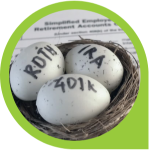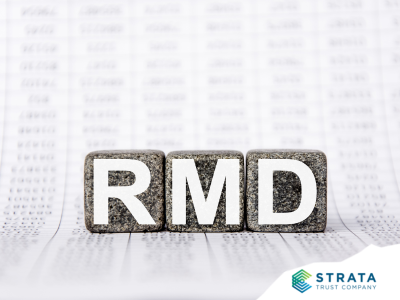The U.S. tax code is complex to say the least. This complexity results in little-known rules that can trip up an uninformed investor, but also in some hidden exceptions that provide opportunities for investors to mitigate the tax consequences on their retirement savings. Even savvy investors and financial professionals should seek expert tax advice when it comes to transactions that could result in a hefty tax bill. Here are a few areas to be aware of while helping your clients evaluate their options and maximize the tax benefits of their self-directed IRAs.
 12-month rollover rule
12-month rollover rule
An investor may roll over one IRA withdrawal to another IRA once every 12 months, regardless of how many IRAs they own. If more than one rollover is made within 12 months, it will be taxable, and subject to the 10% early distribution tax if the IRA owner is younger than 59½. Any amount of the ineligible rollover in the receiving IRA that exceeds the IRA owner’s contribution limit for the year must be treated as an excess contribution. If the excess is not corrected, an additional 6% penalty tax will apply to the excess as long it remains in the IRA.
Direct transfers between two IRAs, rollovers between IRAs and retirement plans, and conversions to Roth IRAs are not subject to this one-per-12-months rollover rule.
 Rolling Over In-Kind Distributions from IRAs vs. Qualified Retirement Plans
Rolling Over In-Kind Distributions from IRAs vs. Qualified Retirement Plans
If your client withdraws property or an investment without liquidating it from an IRA and wants to roll it over to another IRA, the same property must be rolled over. IRA owners cannot sell property or stock outside of the IRA and roll over the cash proceeds.
However, if they take an in-kind distribution from an employer plan, they can choose whether to roll it over in-kind to a self-directed IRA or sell the asset and roll over the cash proceeds to an IRA. The restriction is that they can’t keep the property and substitute their own funds for the rollover.
 Employer Stock Rollovers
Employer Stock Rollovers
If an IRA owner (or beneficiary) rolls over employer stock from that employer’s plan to an IRA, they lose the option to pay the long-term capital gains tax rate on the net unrealized appreciation (NUA). Net unrealized appreciation is the growth in value of the stock that occurred in the plan. Sometimes, the continued tax-deferral gained by rolling the stock to an IRA will be more valuable than the preferential tax treatment on the NUA. But if the NUA option is preferred, your client must follow specific rules to retain that option:
- Stop working for the employer, reach 59½, or be a beneficiary inheriting the account.
- Take a total distribution from the plan within one year.
- Pay regular income tax on the principal cost of the stock.
- Move the stock to a taxable account – the NUA will be taxed at the long-term capital gains rate when they sell the stock.
 10% Early Distribution Tax
10% Early Distribution Tax
Self-directed IRAs are intended to be used as a savings and investment vehicle for retirement, but many of us have good reason to tap into that resource before we retire. If an IRA owner younger than 59½ withdraws taxable assets from their IRA, they will owe a 10% early distribution tax on top of regular income tax – unless they meet one of these IRS exceptions to the additional tax:
- Have unreimbursed qualified higher education expenses (IRA owner, spouse, child, or grandchild)
- Take substantially equal periodic payments
- Receive unemployment compensation for at least 12 weeks and have health insurance premiums to pay
- Have unreimbursed medical expenses of more than 7.5% of their adjusted gross income
- Meet the disability definition under Internal Revenue Code Section 72(m)(7)
- Be named as a beneficiary
- Have first-time homebuyer expenses up to $10,000 (IRA owner, spouse, child, grandchild, or ancestor)
- Are subject to an IRS tax levy (must be paid directly to IRS from the IRA)
- Are a qualified reservist (called to active duty for 179+ days)
- Take a qualified birth or adoption distribution up to $5,000 (per parent, per child)
 Charitable Contributions and RMD Taxes
Charitable Contributions and RMD Taxes
IRA owners who are at least age 70½ may make a qualified charitable deduction (QCD) of up to $100,000 from their IRAs, tax-free, each year. Those who are in RMD status (age 72 and older) may use some or all of their RMD to make a charitable contribution and avoid tax on the RMD they donate. A QCD must be paid directly from the IRA to the charitable organization, so clients must plan and request the QCD before the RMD is paid from the IRA.
 Beneficiary Planning
Beneficiary Planning
The SECURE Act of 2019 changed the beneficiary distribution rules so that fewer beneficiaries are able to stretch out the tax deferral on inherited IRA assets. Most non-spouse beneficiaries, including adult children, must distribute inherited IRA assets within 10 years of the IRA owner’s death – and if death occurs after age 72, beneficiaries will also have to take minimum annual distributions (under current IRS interpretation). The rules for trusts named as IRA beneficiaries have also changed, although the changes are more favorable for special needs beneficiaries. Spouse beneficiaries still have the most options when inheriting IRA assets, including the right to treat the inherited IRA as their own, but some of the timing rules have changed. Clients with large IRA balances or specific estate planning goals may want to check their beneficiary designations against the new rules to determine whether a new beneficiary designation or trust might be necessary to accomplish their objectives.
More Information
STRATA Trust Company (“STRATA”) works with financial advisors, platforms, and other professionals nationwide. By choosing STRATA as an alternative investment IRA custodian, you can broaden your range of services, giving your clients access to a wider range of investment options.
Visit our Rules and Regulations page to learn more about general IRS rules and regulations as they are related to self-directed IRAs, useful tips for maintaining a tax-advantaged status, and important tax reporting requirements. To understand how your clients can leverage the tax benefits of a self-directed IRA, connect with our team of experts or learn more about the financial professionals we work with and how you can start a relationship with STRATA today.















